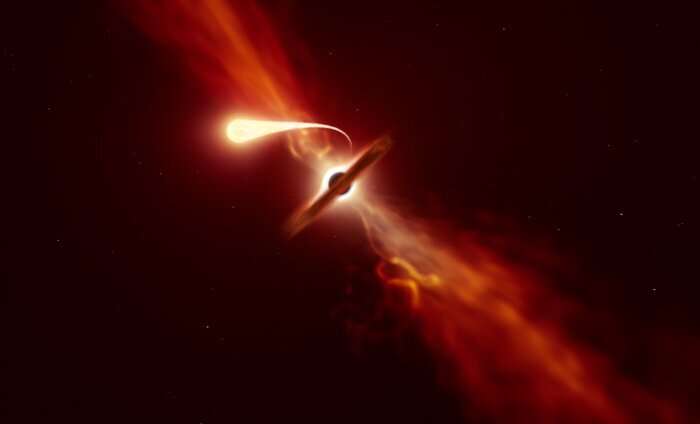This article has been reviewed according to Science X's editorial process and policies. Editors have highlighted the following attributes while ensuring the content's credibility:
fact-checked
peer-reviewed publication
trusted source
proofread
Astronomers witness energetic switch on of black hole

A team of astronomers led by researchers from the University of Birmingham, University College London and Queen's University Belfast have discovered one of the most dramatic 'switches on' of a black hole ever seen. They will present their findings on Tuesday 4 July at the 2023 National Astronomy Meeting in Cardiff. The work will also be published in Monthly Notices of the Royal Astronomical Society.
J221951-484240, known as J221951, is one of the most luminous transients—astrophysical objects that change their brightness over a short period of time—ever recorded. It was discovered by Dr. Samantha Oates, an astronomer at the University of Birmingham, and her team, in September 2019 while searching for the electromagnetic light from a gravitational wave event. The team were using the Ultra-Violet and Optical Telescope on board the Neil Gehrels Swift Observatory to look for a kilonova, the sign of a neutron star merging with another neutron star or a black hole. A kilonova typically appears blue, then fades and turns more red in color over a timescale of days. What they found instead something even more unusual: J221951. The transient appeared blue, but didn't change color or fade rapidly as a kilonova would.
Multiple telescopes were used to follow-up J221951 and determine its nature, including NASA's Swift/UVOT and Hubble Space Telescope, the South African Large Telescope, and ESO facilities such as the Very Large Telescope and the GROND instrument on the MPG/ESO 2.2-meter telescope at the La Silla Observatory.
A spectrum of J221951 taken with the Hubble Space Telescope ruled out the association of J221951 with the gravitational wave event. By examining the light spectrum of J221951, Dr. Oates and her team were able to determine that the source is around 10 billion light years away, in contrast to the gravitational wave signal which was detected less than 0.5 billion light years away. The fact that it shines so brightly at such a large distance makes J221951 one of the most luminous transients ever detected.
Evidence suggests that J221951 came into existence as a result of a supermassive black hole feeding on surrounding material very rapidly. A red galaxy was observed at the location of J221951 prior to its detection, and the location of J221951 is consistent with the galaxy's center, where a massive black hole would naturally reside. It started to shine very suddenly—around 10 months prior to initial detection—meaning the black hole started feeding very quickly after being quiet for some time. The ultraviolet spectrum shows absorption features consistent with material pushed outwards by a huge release of energy. This, combined with its large luminosity, makes this one of the most dramatic 'switches on' of a black hole ever seen.
The team have identified two possible mechanisms that could explain this extreme feeding of a super massive black hole. The first is that it may have been caused by a tidal disruption event—the disruption of a star as it passes close to the supermassive black hole at the center of its galaxy. The second is that it may have been produced by an active galactic nucleus 'changing state' from dormant to active. J221951 would then be the signal that a dormant black hole at the center of the host galaxy has begun to feed on material from an accretion disk.
Dr. Matt Nicholl, a member of the team from Queen's University Belfast, said, "Our understanding of the different things that supermassive black holes can do has greatly expanded in recent years, with discoveries of stars being torn apart and accreting black holes with hugely variable luminosities." He adds, "J221951 is one of the most extreme examples yet of a black hole taking us by surprise. Continued monitoring of J221951 to work out the total energy release might allow us to work out whether this is a tidal disruption of a star by a fast-spinning black hole, or a new kind of AGN switch on".
Dr. N. Paul Kuin, another member of the team from the Mullard Space Science Laboratory at University College London, said, "The key discovery was when the ultraviolet spectrum from Hubble ruled out a Galactic origin. This shows how important it is to maintain a space-based UV spectrograph capability for the future."
Dr. Samantha Oates adds, "In the future we will be able to obtain important clues that help distinguish between the tidal disruption event and active galactic nuclei scenarios. For instance, if J221951 is associated with an AGN turning on we may expect it to stop fading and to increase again in brightness, while if J221951 is a tidal disruption event we would expect it to continue to fade. We will need to continue to monitor J221951 over the next few months to years to capture its late-time behavior."
More information: S. R. Oates et al, Swift/UVOT discovery of Swift J221951-484240: a UV luminous ambiguous nuclear transient, arXiv (2023). DOI: 10.48550/arxiv.2307.01044
Journal information: Monthly Notices of the Royal Astronomical Society , arXiv
Provided by Royal Astronomical Society




















